Building a Siberian Refuge System

In line with our purpose of “Nation Building” based upon the principles of God’s word, we have plans to create an underground “refuge system” within the remote parts of Siberia Russia. This will be a new living system that is built using our own technology to produce energy and food and products within a protected underground environment. All of the needed technology already exists and can be adapted for use for creating our own self-sufficient living system.
Why Russia?
Our reason for choosing Russia is that the current leadership of Russia (under Putin) endorses godly moral values and protects the sanctity of marriage between a man and as woman for the purpose of procreation. Putin also has offered free Russian citizenship and one hectare of free land to whoever will come and develop the remote regions of Russia. We believe in moving to the nation where we have the best offer and Russia has many advantages. It is our purpose to create a community of families whose main purpose is “procreation” and to raise godly children to carry the knowledge of God into the following future generations. See the link “Moving to Russia” for related links.
Khatanga, Siberia Russia

Our selected location is bordered along the Khatanga River where the town of “Khatanga” Siberia hosts a deep river port capable of hosting large cargo ships and also has a large airport runway capable of accommodating large cargo planes. This port town of “Khatanga” is needed for the transfer of materials and machinery and personnel for building our refuge system. The Khatanga ports can be used to offload cargo from ships and the Khatanga runway can be used to land aircraft bringing in needed personnel and gear to this remote location. See the link “Khatanga Russia” for more details.
Refuge System Location
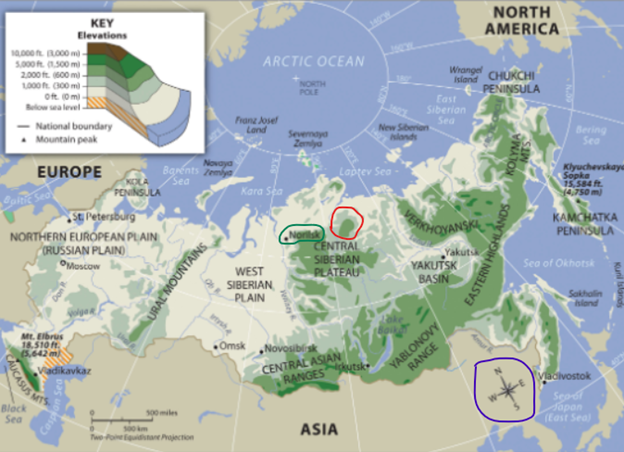
The image above shows an elevation map of the Central Siberian Plateau. The direction icon (circled in blue on the lower right side of the image above) displays the directional layout of the plateau. The mining town of Norilsk (circled in green) lies on the northwestern side of the plateau. The target region for developing our “living system” is located on the northeastern side of the plateau (as circled in red above). The regions shown in medium-green shading-color above are between 2,000 feet (600 meters) and 5,000 feet (1,500 meters) in elevation. The areas shown in light-green shading-color are from 1,000 feet (300 meters) to 2,000 feet (600 meters) in elevation (above sea level).
Geological Hinderances
Structural geology is important when considering a location for building an underground tunnel system. One of the biggest hinderances that can cancel out projects involving tunneling operations is the geological-structure of that region.
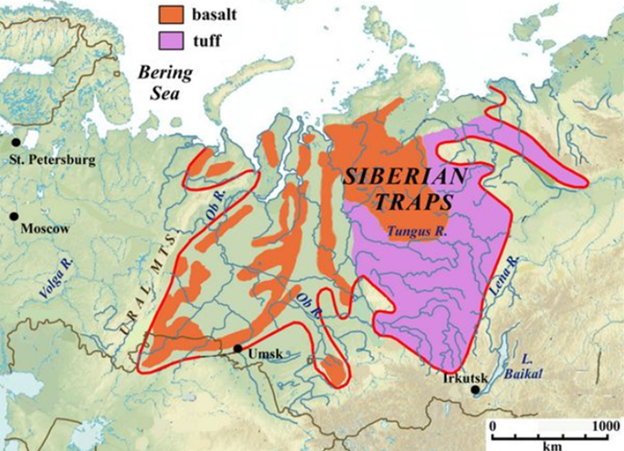
The geological map above shows areas of Basalt (colored in orange) and areas of Tuff (colored in purple). This map shows that the region of Norilsk is located on an area comprised of Basalt. This is a type of lava-rock that can be extremely hard to drill or tunnel through and is hard like molten glass. In contrast to this is “Tuff” volcanic rock formation which is easy to cut (even with hand-tools) yet it has great strength for supporting underground caverns or tunnels.
Geological-Tuff-Strata refers to a stratum of volcanic material which is ideal for tunneling. This type of rock formation can even be cut with simple hand-tools but has great load-bearing strength for creating underground tunnels and caverns.
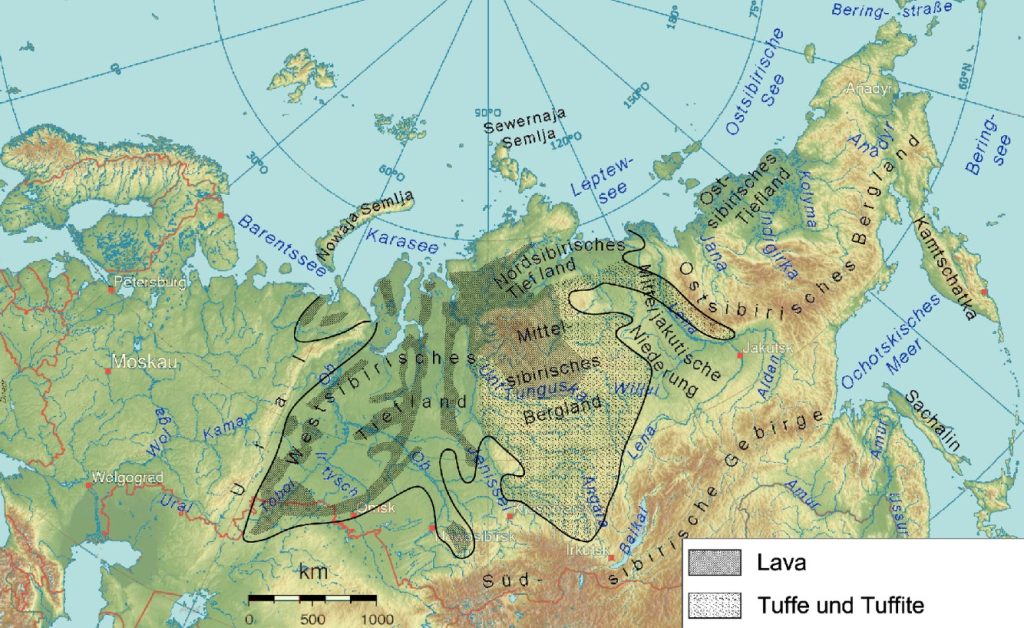
The map above is a German geological map of northern Siberia showing regions of lava formation called “basalt” as well as regions of Tuffe or (Tuff in English). It is this “tuff” soft volcanic rock formation which is excellent for tunneling and making underground structures.
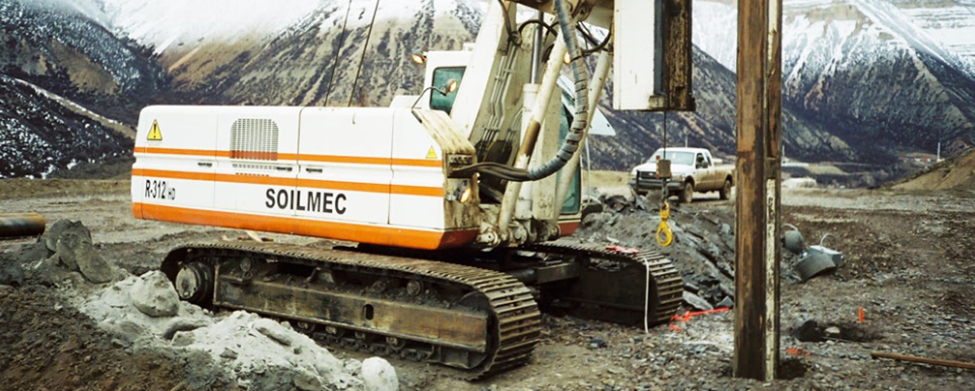
I previously worked for a drilling company (which utilized the tracked drilling rigs as seen above) which prepared sites for oil rigs. We would drill something called a “Rathole” (which is basically a “parking place” comprised of a deep vertical hole or shaft), which the big rigs use to place their long sections of drill-pipe before they attached them to the deep drill-shaft they were using. The Soilmec drilling-rig seen above can go down to 120-feet deep, with a telescoping “kelly” and can go deeper if they use an extension. They attach something called a core-barrel on the end of the “kelly” and this can pull cores of rock and excavated material up to 36-inches in diameter. On the outside perimeter of the core barrel, they mount carbide drill-bits which are used to drill through solid rock.
The reason I mention this is because when we struck “Basalt” while drilling, then we had a difficult time to drill through it. Much time and expense were wasted by having to constantly replace the very expensive carbide-drill bits. These carbide drill bits would snap-off constantly, if we were trying to drill through a “Basalt” rock formation.
Again, a “Basalt” rock formation is a similar to drilling through a bed of “molten-glass” type of material (which is extremely hard) and can easily break the hardened carbide bits. It is for this reason, that I was looking at a geology map trying to find a location to make our underground tunnels and caverns, which was not comprised of volcanic “Basalt” (which can greatly multiply the time and cost of trying to tunnel through such a nearly “impossible” type of hard material.
Ancient Underground Cities Cut Out of Volcanic “Tuff” Rock Strata
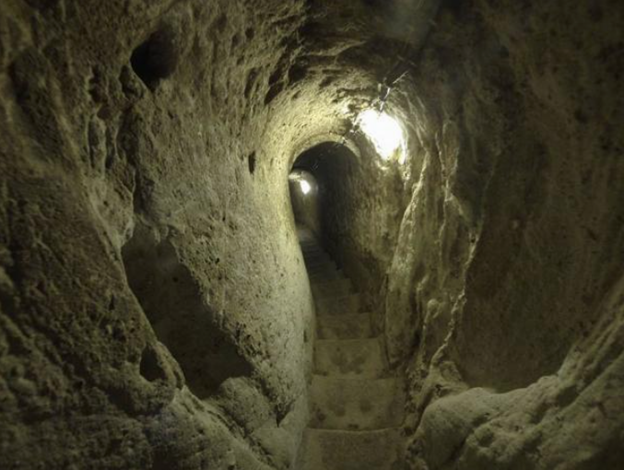
The image above shows a tunnel that was cut out of soft volcanic rock called “Tuff” using only hand-tools and manual labor. This tunnel is part of the ancient underground cities discovered in what is now present-day Turkey. This is part of a vast underground city network which covered 172 square miles or 445 square KM. There are stables, apartments, communal rooms, chapels, tombs, and even wine and oil presses. The passageways are all “secured” by 1,000-pound (454 KG) stone doors that can only be opened from the inside. Just one of these underground cities could hold over 20,000 people. It is said that there are over 200-underground cities in this region alone. These cities were connected by tunnels (some of them 4-5 KM in length (for traveling between these cities).
It is believed these underground cities were used by Christians as a hiding place during the time of the Roman persecution. They could grow crops on the surface and harvest grain or grapes or vegetables at night and bring the food into the underground city via carefully disguised tunnel entrances. These entrances were so well hidden that this underground city was not discovered until 1963, when a local man accidently broke into the one of the tunnels located behind the wall of his house.
These underground cities were found in the Cappadocia region of present-day Turkey. They were carved out of the region’s soft volcanic rock, known as “tuff” and all of this was done thousands of years ago using only hand-tools and manual labor. This is an example of excellent “ancient-engineering” and was complete with ventilation shafts, water wells, water tanks, and an extensive network of passages and tunnels located on multiple levels. This system even had the capability to cut off the water wells from the surface to keep their enemies from poisoning their drinking water. They also had places for cooking over wood-fired stoves with chimneys for expelling the smoke. Cooking occurred only at night so that the smoke emitted from the chimney shafts would not be easily seen. See the Utube video “Underground City“ for more details.
Tuff Soft Volcanic Rock Mined by Machines in Present Times
If these ancient people would do such extensive work with only manual labor and hand tools, then how much more can we do if we utilize modern day tunneling boring machines (TBM) and modern drilling equipment? It is our goal to create a place of refuge for our people that is resistant to just about any type of natural or manmade disaster that can be imagined. Instead of growing crops on the surface however, we have the technology to grow food underground within a self-sufficient system which can create energy and food and products needed to sustain human life indefinitely. Regardless of what type of disaster may occur, our people could outlast the longest period of trouble.
For example, if there was a nuclear disaster that poisoned the earth’s surface for a 1,000-years, then our people could actually outlive that crisis and their descendants could emerge safely over ten-generations later, after the radiation has subsided. In this manner, they could outlast any type of crisis regardless of duration.
Our system can also be designed to recycle the water within (in the event that the surface water is contaminated by radiation or an oil spill or any other pollution or toxin). We can cut off the surface water supply, then utilize a system of water recycling and purification from our huge underground cisterns designed for this purpose.
Soft Volcanic Rock “Tuff” is a Perfect Medium for Tunneling
Again, the underground cities discovered in present-day Turkey could hold hundreds of thousands of people within their combined capacity. All of them were cut out of the soft volcanic rock known as “Tuff” which is easy to tunnel through but is very strong. There is no evidence that there were any cave-ins within this vast underground city. This is why this soft volcanic rock called “Tuff” is the prefect medium for tunneling because it is easy to cut even with hand-tools but is incredibly strong (after in hardens) for load-bearing applications in tunneling.
This is why we want to drill test holes within the geology of the locations where we plan to build our underground cities. We are looking for the same geologic material comprised of soft volcanic rock called “Tuff” so we can have the same excellent medium as was used by the ancient builders of the underground cities located in what is now present-day Turkey. For more information see the link “Underground City-Ancient Origins” for more details.
Developing an Artic Opportunity
The image below depicts that the northern border of Russian (along the Arctic Ocean) is warmer than the borders of both Alaska and Canada located on the opposite side of the North Pole. This is because of the tilt of the earth toward the sun, which makes it warmer and provides increased thawing of ice on the Russian side of the pole.
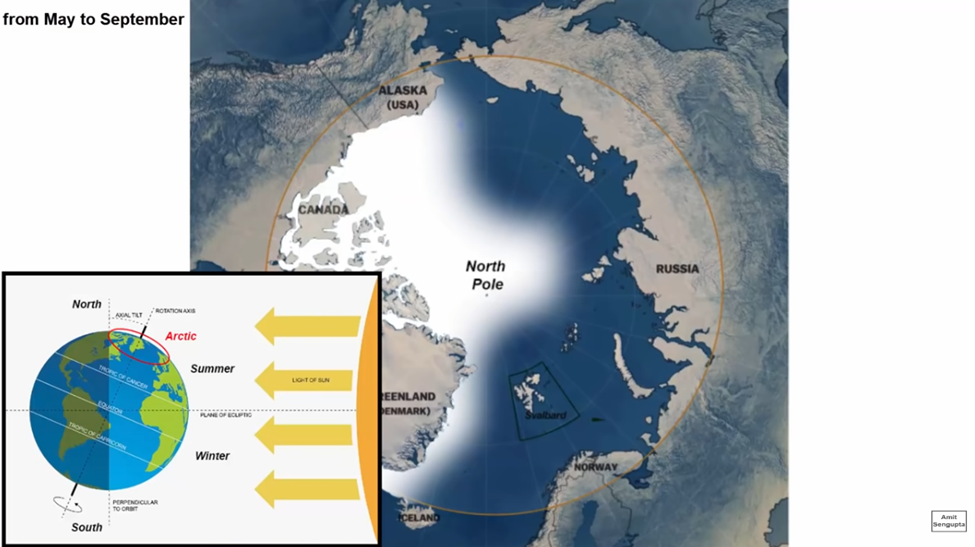
The North Pole tilts toward the sun (as seen in the illustration above) and this results in the thawing of the northern coast of Russia. This thawing of ice along Russia’s northern coast provides for them a unique opportunity because the trade route through the Suez Canal takes a full 48-days compared to only 20-days for the Northern Sea Route (between the same two points). The development of ports along this Northern Sea Route is also a great advantage for us in building a subsurface living system within this region.
Another development is that the Panama Canal is drying up so this event would place even more importance on the “now thawing” Northern Sea Route along the coast of Russia. See the video link “Panama Canal Threatened” for more details.
This entire region could begin to boom as a result of these events which serve to redirect world trade along the Russian Northern coast. We also have the technology to build underground infrastructure (even in permafrost) and also produce food and energy and products to sustain large human populations in the most harsh environments on earth (including Siberia).
Food Supply Opportunities
Our system can produce fresh food all year-round within our underground subsurface growing systems. This is a great advantage for the Russian ports along the Northern Sea Route and for the ship crews and workers that will pass through and work within this area. We can have a profitable business in selling fresh food grown locally rather than having everything shipped in for workers to eat.
Our living system can result in a comfortable and healthy subsurface environment that can produce fresh food all year-round regardless of extreme temperatures. Our people can also prosper as “food producers” selling both fresh food and dehydrated foods (for Artic surface use) to a growing population of workers and ship crews in that region.
This is a win/win situation for everyone involved by providing critical needs for food to those working along the Russian Northern Sea Route and creating an income source for our own local food producers.
Our skilled technicians can also provide a wide range of industrial services and repairs serving those operations working along the Northern Sea Route. In this manner, machines and equipment can be repaired on location (thus avoiding costly and time-consuming repairs) which no longer have to be shipped out for service.
Korea in Need of Land Space
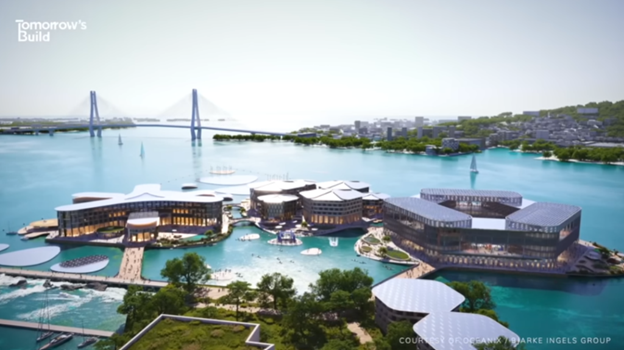
The image above shows a proposed “floating city” to be built at Busan in South Korea. This project would be hugely expensive and will house only 100,000 people (a tiny fraction of the Korean population). But by comparison, we could build an underground city under the Central Siberian Plateau which would be a much better value. Our project would include production facilities to grow food and create products and generate clean energy for a self-sustaining system that could operate indefinitely. Such a system would also be immune to just about any type of manmade or natural disaster that could be imagined.
Korean Tunneling Expertise
South Korea is a mountainous country and they have built an enormous number of tunnels through their mountains (every time a highway or railroad passes through any of their many mountains (which cover much of their country). They cannot build much infrastructure without having to tunnel through mountains in most places. Therefore, Korea has the tunnel boring machines and the expertise to create tunnels.
Existing Transport and Available Land
Nornickel Mining Corporation delivers industrial metals to Busan, South Korea on a regular basis so it would not be difficult to load tunnel boring machinery on the same cargo ships that return back “empty” to Dudinka and Norilsk. Russia has already offered free land in Siberia for those who will come and develop it. (See the link “Russia Offers Free Land” for more details) The land we want to develop (under the Central Siberian Plateau) would be ideal for an underground refuge system (which can be created above sea level) under this massive plateau.
Korean Development Corporation
What we want to do is form our own development corporation in partnership with the South Korean government to develop the world’s most extensive underground city (in Siberia) which is completely self-sufficient in energy and food and products needed to sustain human life within a protected environment. If South Korea is already planning to host a prototype “floating city” at Busan, then we can offer them a much better value for a self-sufficient underground living system in Siberia. Our system not only offers housing but also food and products and energy production so it has the potential to pay for itself. Sales of food and services to those working along the North Sea Route would enable us to pay back the construction costs for building such a system in Siberia.
This system would be a boon for Russia in aiding the development of their North Sea Route. Also, a self-sufficient system such as this can help the country to become self-sufficient (and sanction proof) since this system (when completed) is not dependent on outside global trade.
Developing the Northeastern Section of the Plateau
The Central Siberian Plateau is enormous in size (comparable to the land-space of the nation of Great Britain). Tunnels could go for hundreds of kilometers creating a system that could potentially host a huge population (not just a tiny 100K people, sitting on a few floating cities – that are without any production facilities whatsoever). Our system is better for everyone involved and would be a great blessing for both Russia and Korea combined.
What we want to do is build our project on the Central Siberian Plateau on the northeastern corner. In this manner, we can be as close as possible to the Northern Sea Route, which is necessary to move machinery and equipment and materials by ship or barge through the Artic Ocean. We can also utilize the deep rivers that flow into the Artic Ocean for moving machinery and materials to our job site.
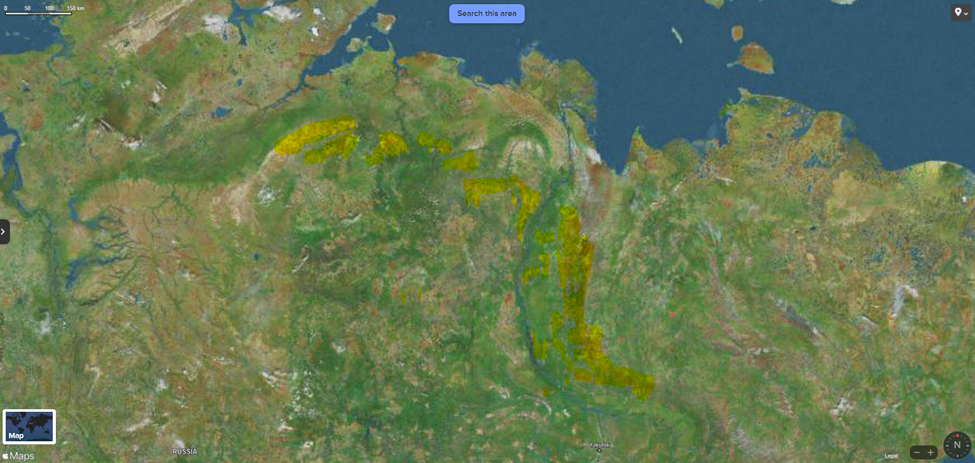
Based upon available geology maps, the areas high-lighted in yellow above should be comprised of volcanic “tuff” which is an excellent medium for both drilling and tunneling. “Tuff” is a soft volcanic rock which is easy to cut but after it is exposed to air, then it hardens into a strong rock formation. These areas in yellow-highlight above are also elevated above sea level and thus resistant to natural disasters such as tsunami waves, which can be caused by earthquakes under the ocean or meteor strikes upon the ocean or even nuclear devises exploded under water. The areas highlighted above provide us with the needed elevation, and the needed proximity to the Artic Ocean, and have deep rivers nearby for moving necessary machinery and materials to our job site.
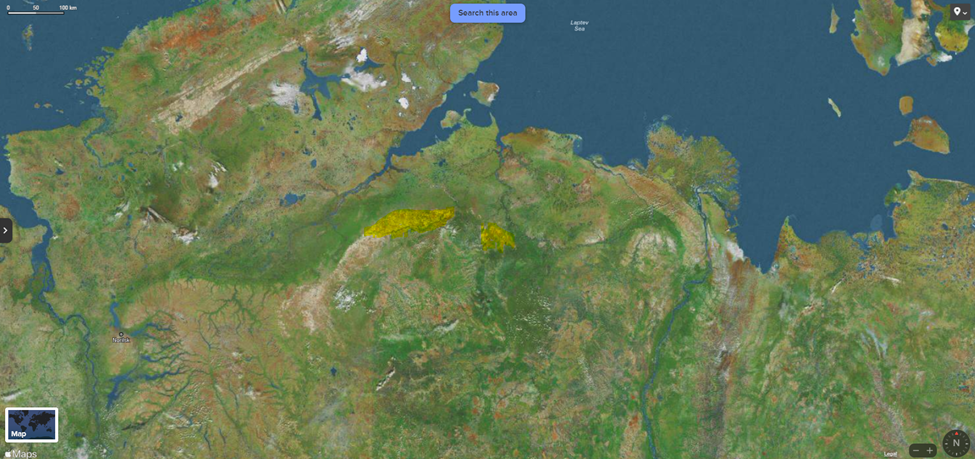
These two areas highlighted above have most of the criteria we are looking for with the highest elevation in this location (on top of the Central Siberian Plateau) so that “multiple” horizontal tunnels can be made at various levels with all of them being above sea level.
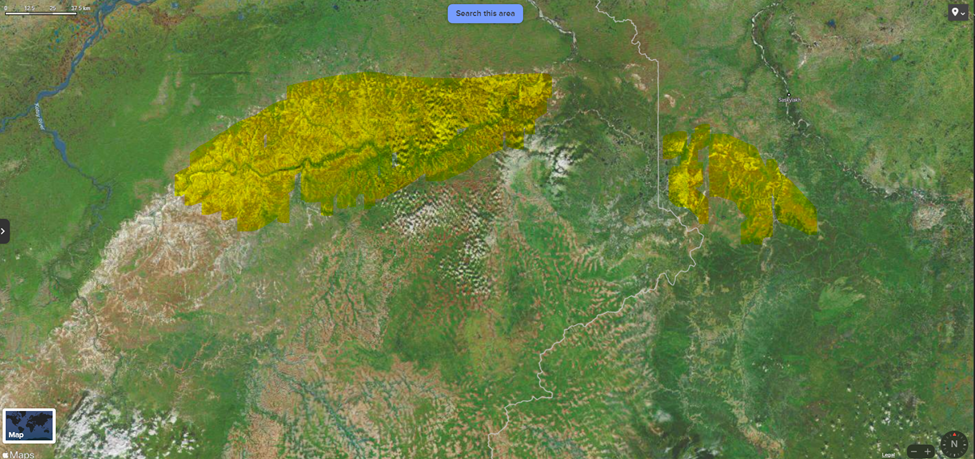
The two regions highlighted in yellow above are located directly on top of the Central Siberian Plateau. They have the deep river routes nearby for access to the sea for moving cargo. These locations also are listed as having volcanic “Tuff” rock substrata for excellent tunneling and drilling operations.
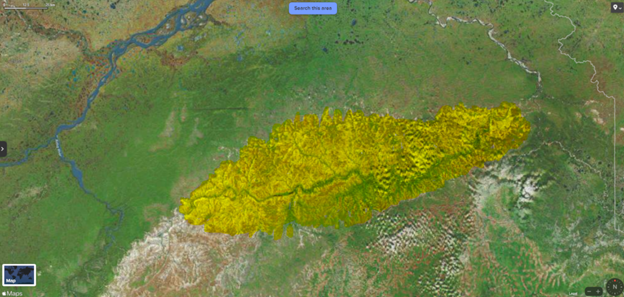
Finally, this ridge highlighted above has all of the qualifications because it has the best source of surface water (including numerous lakes and a large river network). This section of the plateau would provide the highest elevation plus the elevated flowing water source, which we need for hydroelectric power generation. It is also comprised of “Tuff” substrata for excellent tunneling. According to the map scale, this highlighted region above should be approximately 200 KM long and 50 KM wide.
Elevated Water Sources
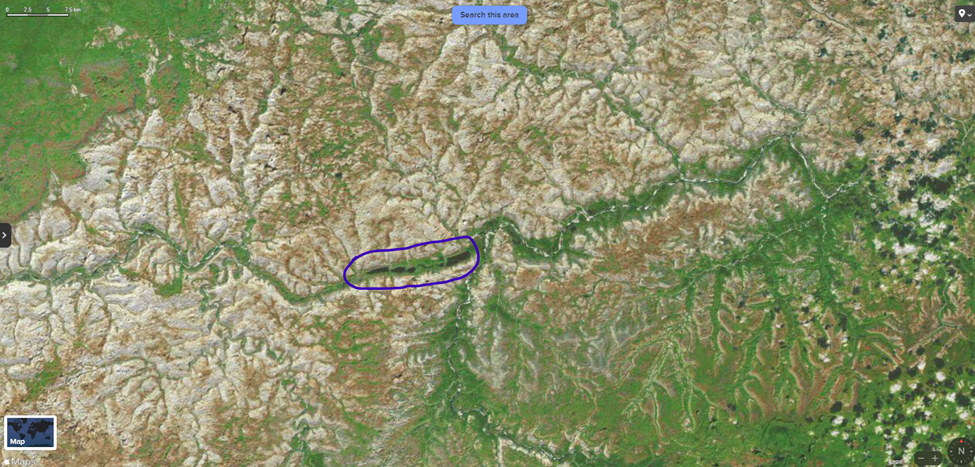
The section of river bed circled above, has four major lakes, located on top of this plateau, which are replenished by rivers emptying into them and a river flowing through them.
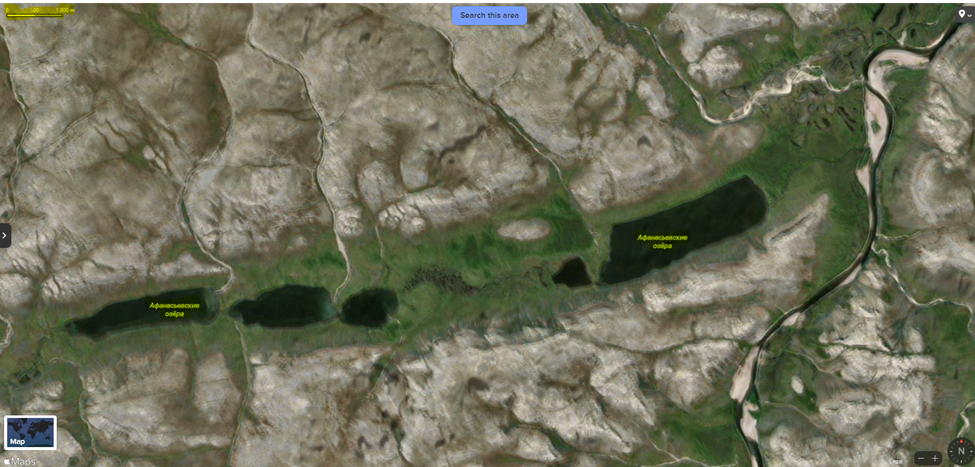
According to the map distance scale, the larger lake on the right side could be approximately 1 KM wide and over 3.4 KM long. The lake on the left side could be about 500 meters wide and 3.0 KM long. There are also some smaller lakes between them as well, which are still of significant size.
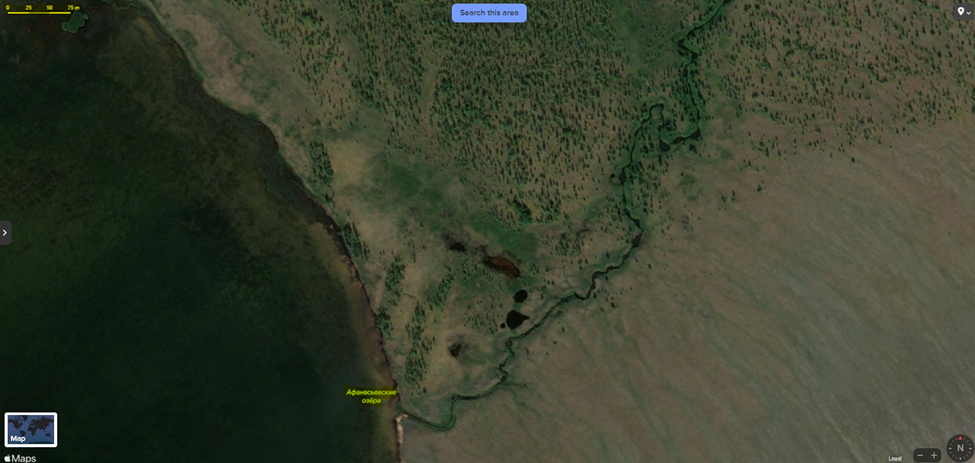
The larger lake on the far right, shows a river flowing through a forest and into this lake. The trees of the forest (seen on the right side of this image above) show the scale and size of just how large this body of water actually is.
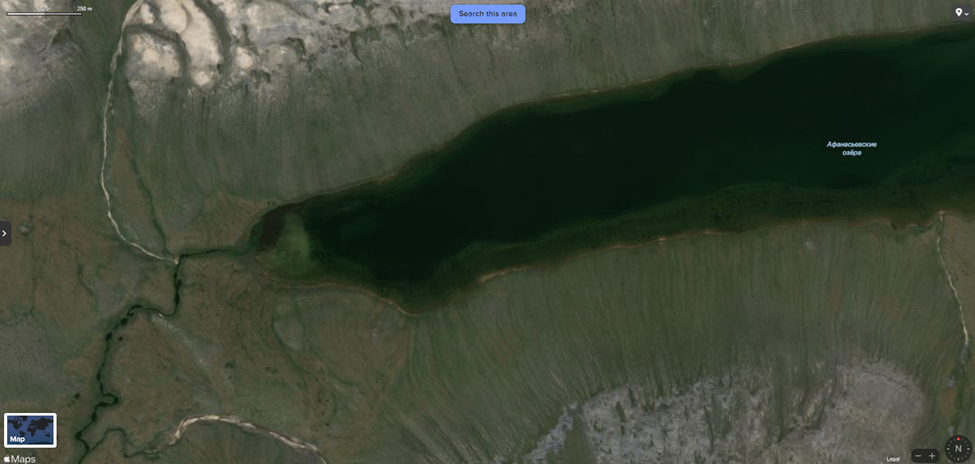
The lake on the far left shows a river exiting the lake, indicating there could be a continual flow of fresh water passing through these series of lakes (which are all located within this same river basin).
Bodies of water of this size could hold a lot of water and could have a potential for an almost unlimited water supply of flowing river water, needed to fill underground cisterns and operate hydroelectric generators and irrigate crops within our underground plant growth systems.
This is only one example of the numerous lakes and rivers flowing within this one section of region located on the top of the Central Siberian Plateau.
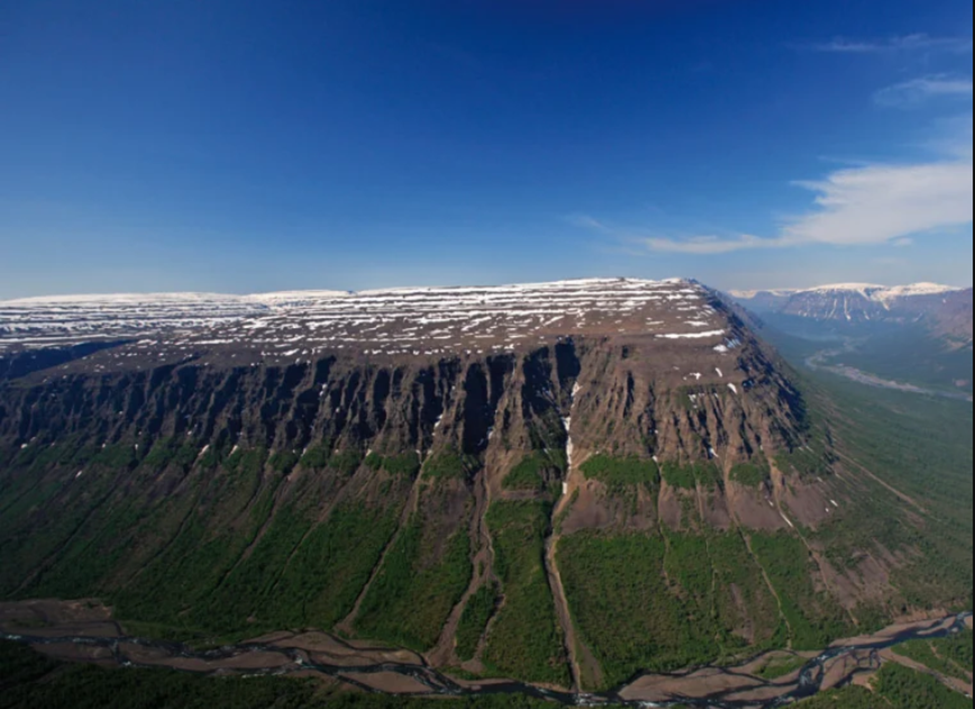
A plateau is a large flat area of land that is higher than other areas of land that surround it. The Central Siberian Plateau has numerous advantages for building an underground (self-sustainable) living system (which is resistant to most manmade and natural disasters). The plateau ranges from 1,650-2,300 feet or 500-700 meters above sea level. This means that if there is a great tsunami caused by earthquake, or meteor strike in the ocean (or even a nuclear blast within the artic ocean), then our refuge system would have the greatest chance of survival. It could remain above sea level and above the highest tsunami level. Even if it was possible for a tsunami to reach over 1,650 feet, then it would not remain long but would quickly return back to the ocean again. There is little chance of underground flooding within our tunnels (due to a tsunami) when these tunnels are elevated above sea level.
The greatest advantage of the plateau however, is the presence of elevated water sources. There are hundreds of lakes and dozens of flowing rivers located on top of the plateau. Whenever water is elevated, then this can be utilized as an unlimited supply of hydroelectric power generation (as well as a water supply needed for irrigation of plants and crops grown within our underground plant growth system).
Water can be stored within vast underground cisterns, which can keep it above freezing temperature during the long winter months. These underground reservoirs can be filled during the summer months from (June to August) and then be utilized and recirculated during the winter months.
Above is an image of a section of the Central Siberian Plateau, which is located in northern Siberia and has an area of 600,000 square miles or 1,500,000 square KM. The average elevation is 1,650 to 2,300 feet or 500-600 meters. There are numerous rivers on top of this plateau and this “elevated water” source has great potential to produce vast amounts of hydroelectric energy. It is for this reason we are seeking to find the parts of this plateau for our construction projects which are comprised of volcanic “tuff” rather than the overly-hard “Basalt” formations.
West to East Map Orientation
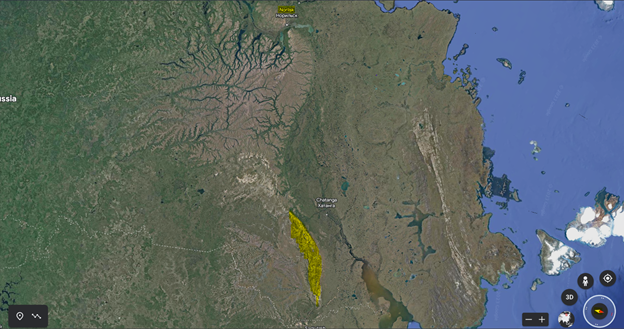
Above is a view from a different orientation with Norilsk in the west (top of the map) and our target region highlighted in yellow in the east (at the bottom of the above map).
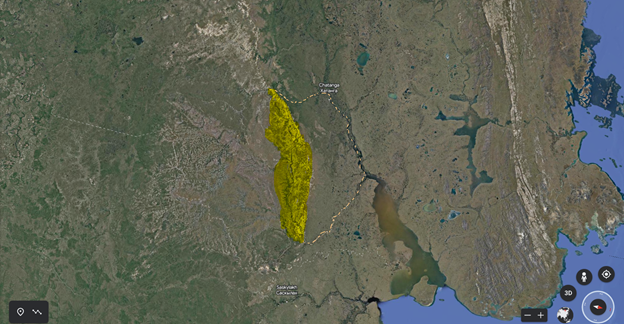
The highlighted region of the plateau as seen above and the plain located in front of it are the area we would like to develop.
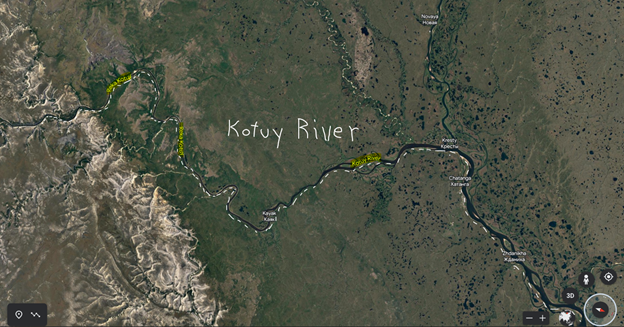
The western boundary is located at the Kotuy River.
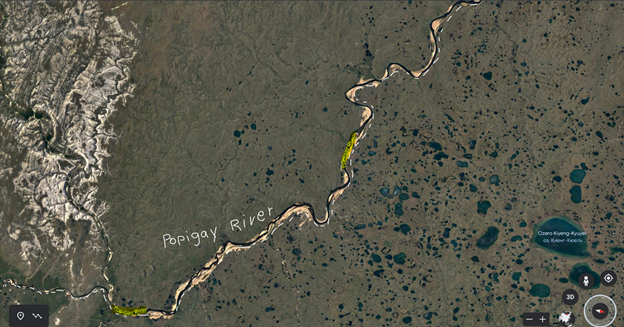
The eastern boundary is located at the Popigay River as seen above.
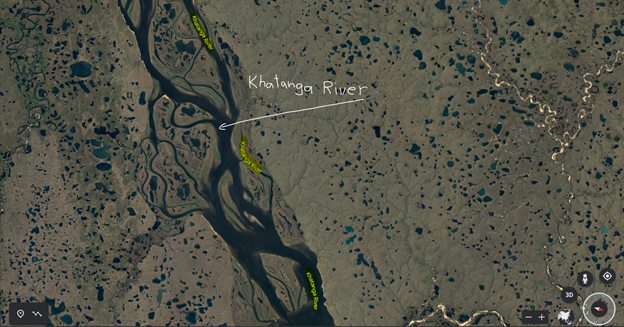
The northern boundary is located along the Khatanga River as seen above.
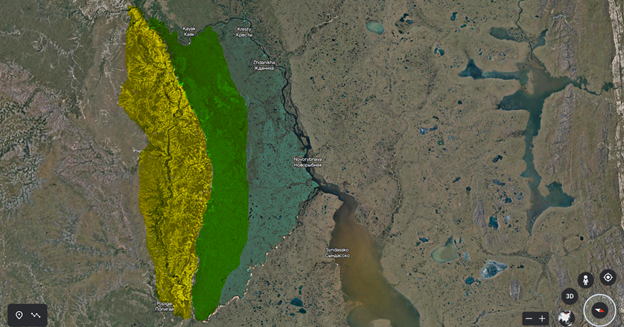
Above I have colored three different zones within the described borders of our target land mass as is bordered by three rivers on the east and north and west.
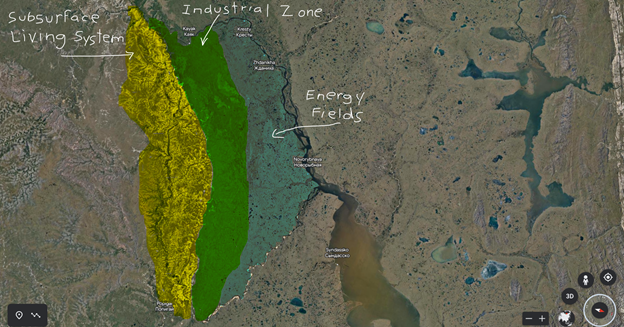
The region highlighted in yellow-color above designates the area we plan to build our subsurface living system. The region highlighted in green-color designates the area we plan to use for an industrial zone. Finally, the area highlighted in bluish-color designates the region we plan to use for energy fields.
North to South Map Orientation
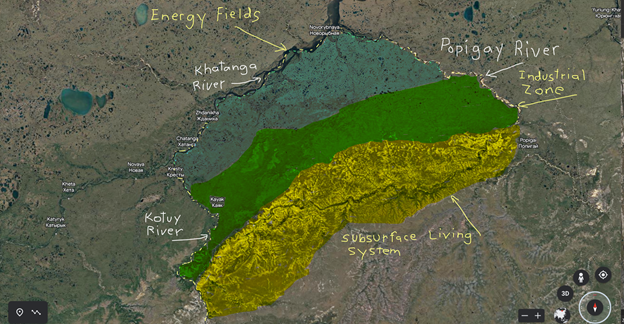
When our targeted land parcel is viewed from a north and south perspective then the Katanga River is on the north and the Popigay River is on the east and the Kotuy River is on the west. The section of plateau that is elevated above this plain is highlighted in yellow above and is used for subsurface living systems. The green zone below on the plain is for an industrial zone and the bluish-green color (pitted with lakes) is targeted as potential energy fields.
Energy Fields
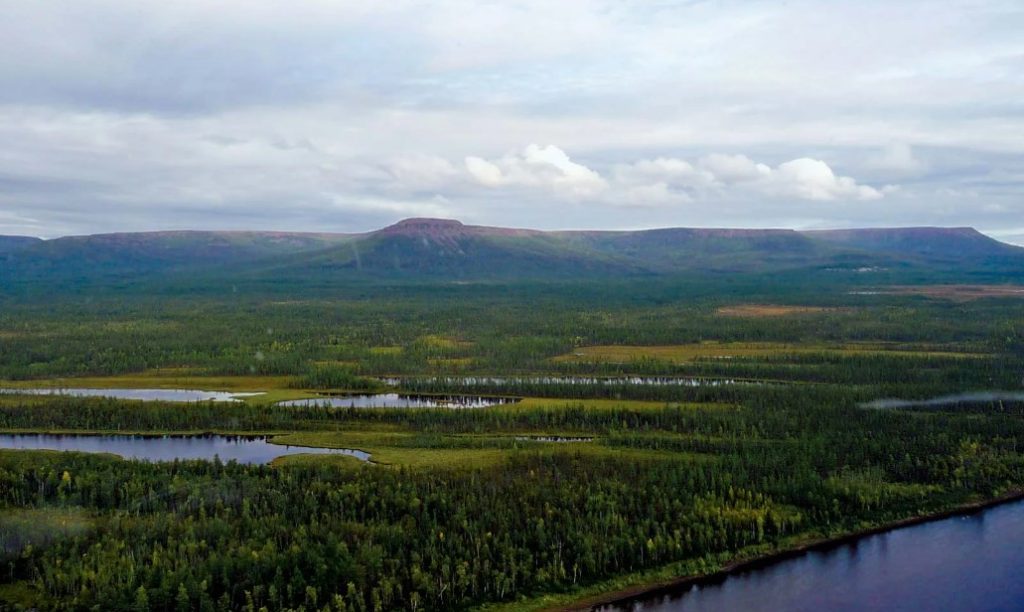
The image above shows some of the numerous lakes situated on the plain that spreads out before the plateau.
The image below shows just how numerous these lakes really are.
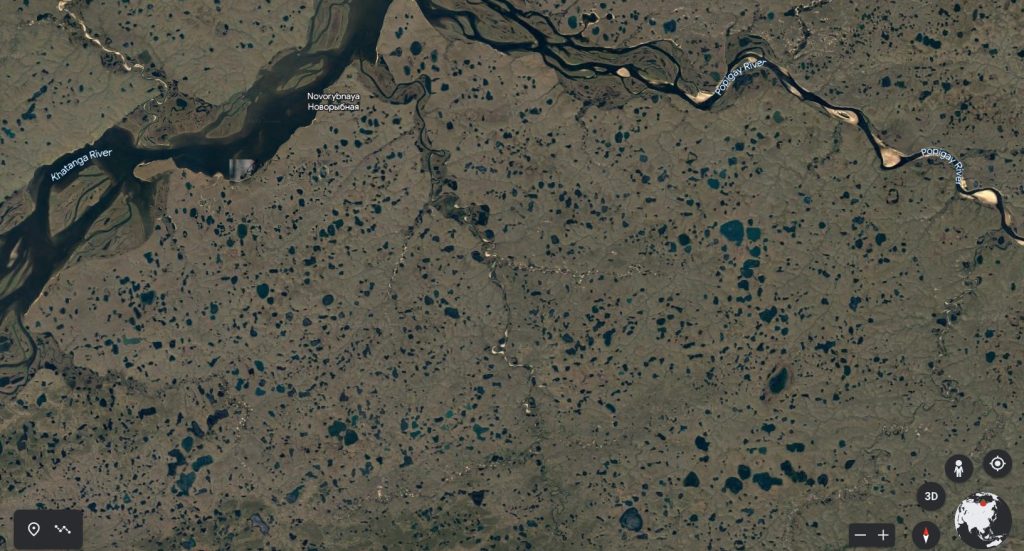
This region lying between the junction of the Khatanga and Popigay rivers is literally “dotted” with natural lakes. What we want to do is utilize these lakes as a water source of hydroelectric generation. The development of what we call a “Belgium-Pipe” enables us to generate electric current using these numerous lakes as a water source to keep our hydroelectric devices operating continually. See the link “Belgium-Pipe” for more details.
Size of Our Proposed Land Development Region
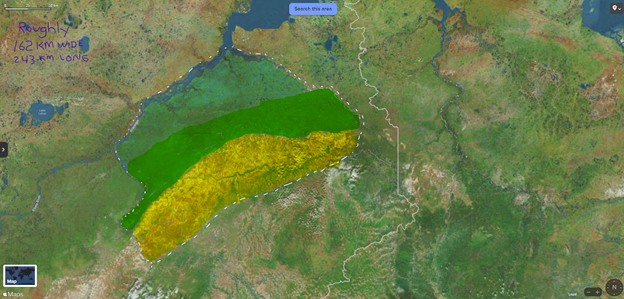
This image above from Duck Duck Go maps contains a distance scale (so based on this scale) this region could be roughly 162 KM wide and 243 KM long.
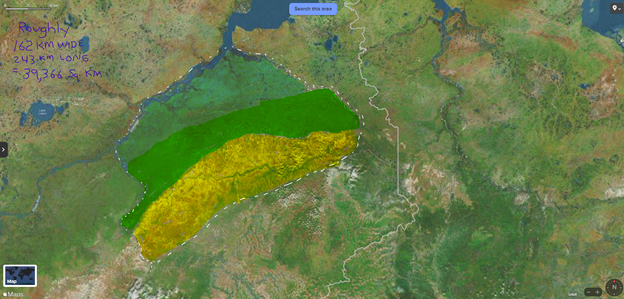
The distance scale might not be accurate but if this targeted land region is about 162 KM wide and 243 KM long then this would equal to roughly 39,366 square KM. If we round this figure up to say “40,000 square KM” then this can give a general idea of the size of this designated parcel as outlined above.
Again, if this parcel of land outlined above is 40,000 square KM and there are 100-hectares within one square KM, then this would equal to 4,000,000 hectares. If the Russian government has offered 1.0 hectares per family (See the link “Russian Offers Free Land” for more details) plus 1.5 hectares for industry and infrastructure (for a total of 2.5 hectares per family) then 4,000,000-hectares divided by 2.5 hectares per family would provide land shares for 1,600,000 families. This means that we could make an offer to develop this land region outlined above and receive the land as a group of 1,600,000 families and develop it jointly for the benefit of everyone within our group.
The current population of the Republic of Korea in 2023 is 51,395,094 so if we had only 1,600,000 Korean families transplant to our new Siberian location, then that is less than .03% of the current population of Korea. This however would greatly help Korea with their problem of a lack of land space and this pioneering opportunity also provides our young men with incentive to marry and start families (thus helping to reverse the current “negative” population growth rate of South Korea).
Once this “Korean sector” is functional then we will then begin to develop additional sectors which can house people of different nationalities and languages (such as are found in Russia already). Even qualified foreigners can be brought in from other nations with each group having a development sector for their own people (whose people groups also belong to our association).
Korea Has the Technology
Korea has the technology to build the Tunnel Boring Machines (TBN) that we need and they can create all of the necessary equipment needed to build our underground living system. Below are some images taken from the website of the Korean company “Hyundai Heavy Industries” which builds ships and oil rigs and massive machines and infrastructure needed for large scale industrial projects.
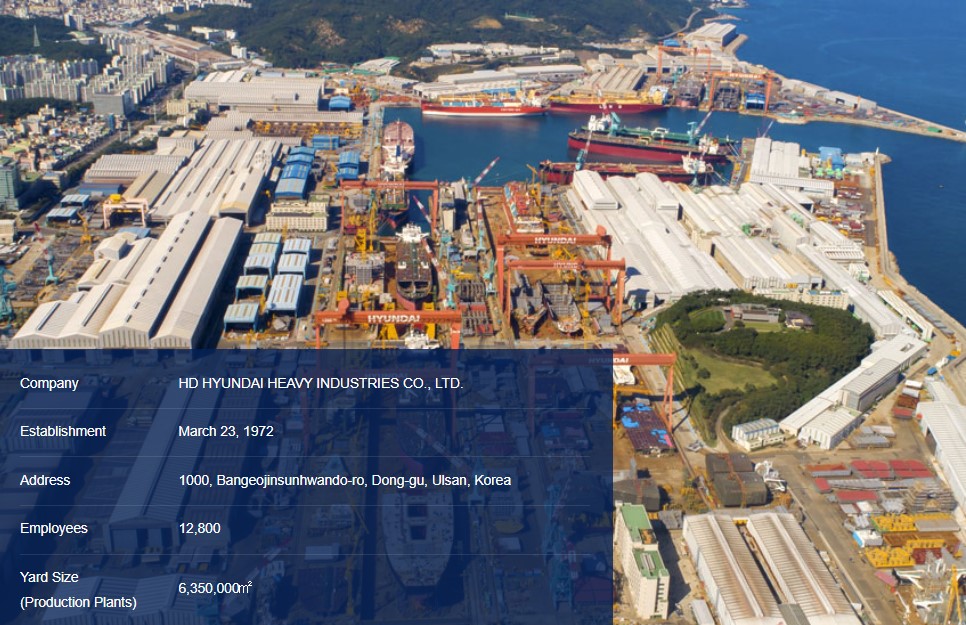
Hyundai Heavy industries is capable of building large ocean-going vessels and even specialized “ice-breaker” ships currently used on the Northern Sea Route.
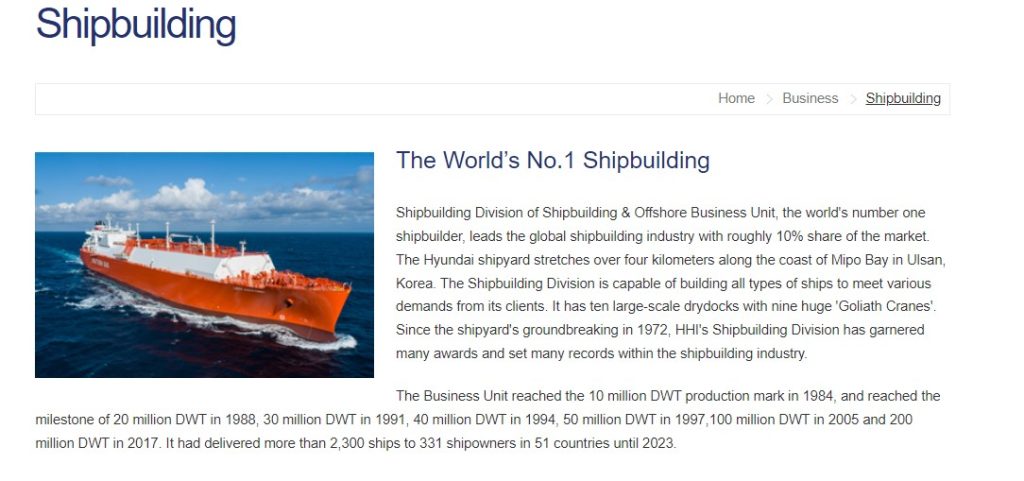
Hyundai Heavy Industries is rated as the number one shipbuilder on earth, showing their advanced industrial manufacturing capabilities.
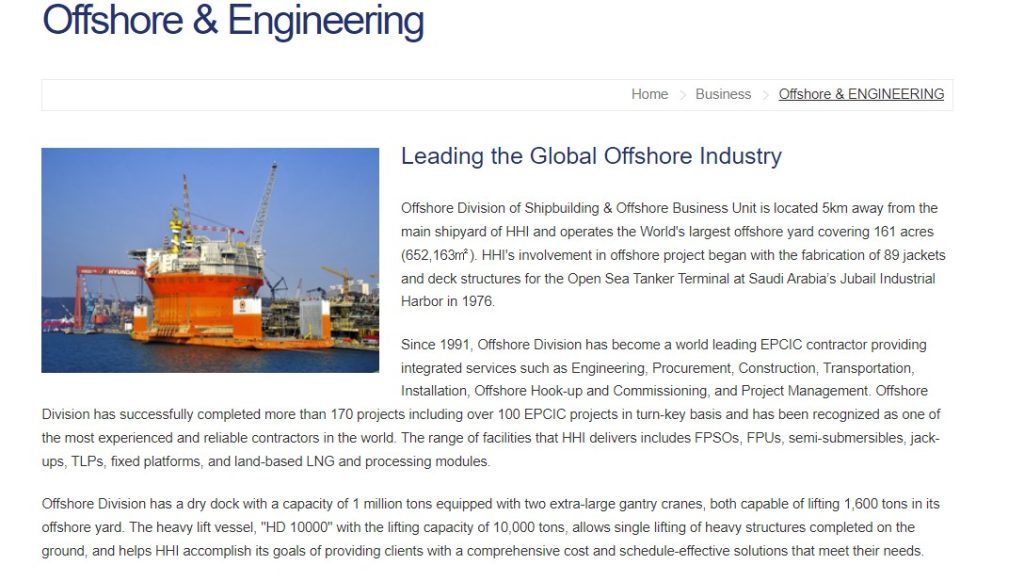
Above Hyundai Heavy Industries also builds off-shore drilling rigs and infrastructure needed within the gas and oil industry. Building this custom heavy machinery shows that they possess the technology to build just about any type industrial machine that can be imagined.
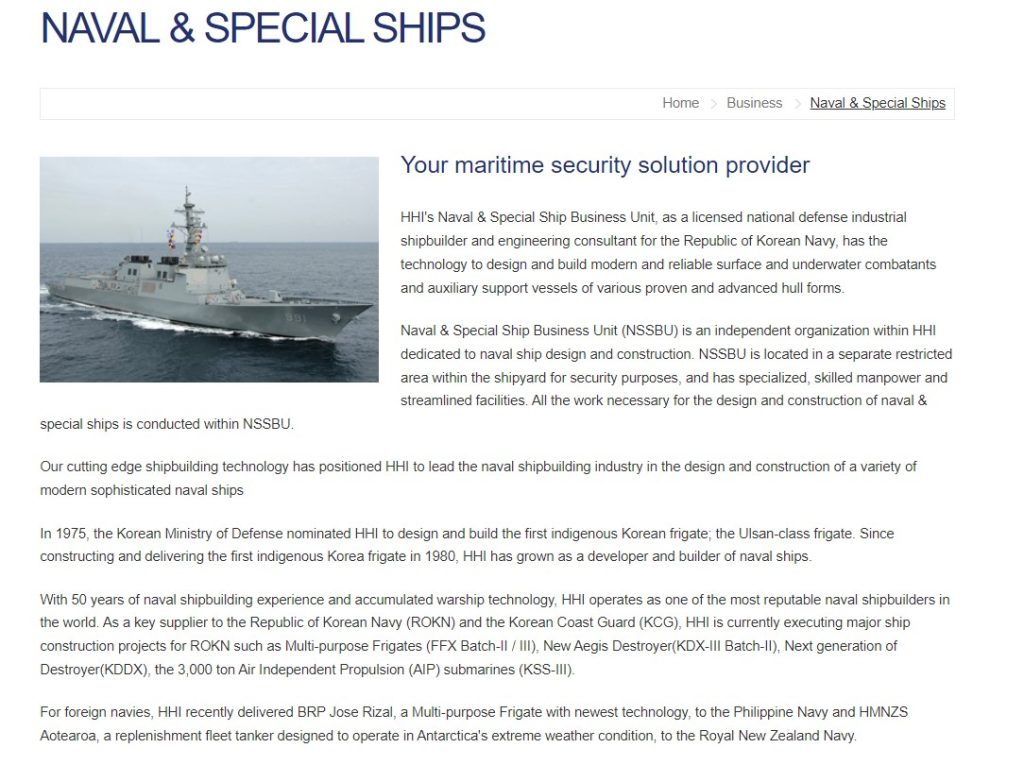
Hyundai Heavy Industries also builds military naval ships, again showing their capability and creating high tech weapons systems for navies around the world.
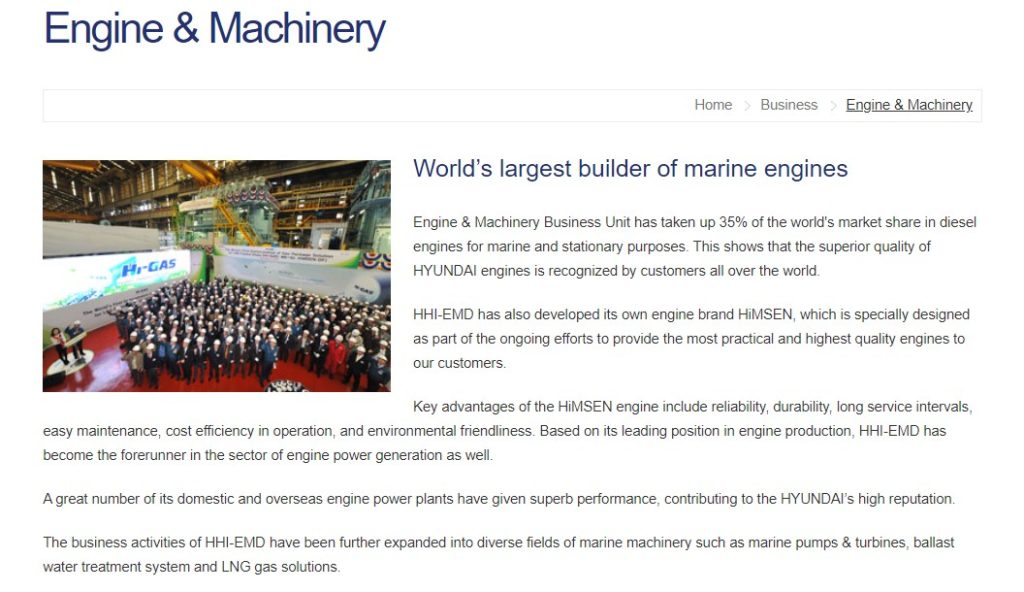
Hyundai Heavy Industries also manufacture the massive engines used to power great ships at sea. They have the engineering and manufacturing system needed to create any component used for ship building (including large scale engines).
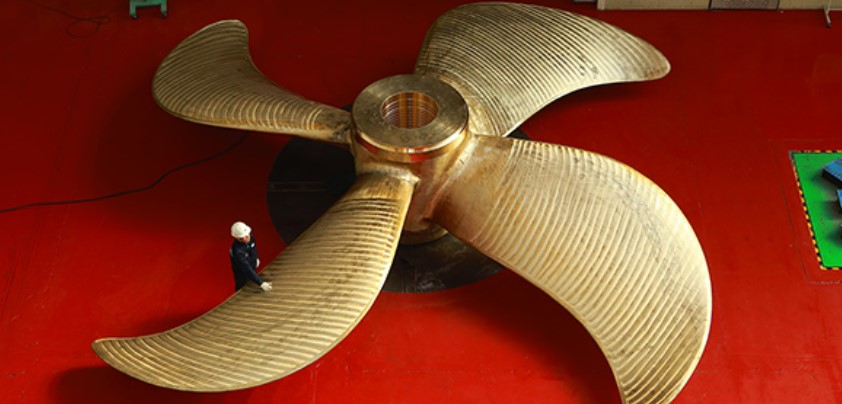
Above, is an example of “specialized” ship building components built by Hyundai Heavy Industries (such as this mammoth-sized ship propeller).
Massive Custom Built Tunnel Boring Machine (TBM)
We want to manufacture a massive Tunnel Boring Machine (TBM) that is controlled by AI technology. It will be made so that it can install our “Family Production Units (FPU) with a single pass. The experience that the Korean Company Hyundai Heavy Industries has with building big drilling rigs and massive marine engines and military ships and high-tech systems can all be applied to building our “custom-made” (TBN) which is needed to install our FPU Living Systems underground. Below is an image of a (TBM) built in Japan with a 57-foot (17.4 meter) diameter cutterhead.
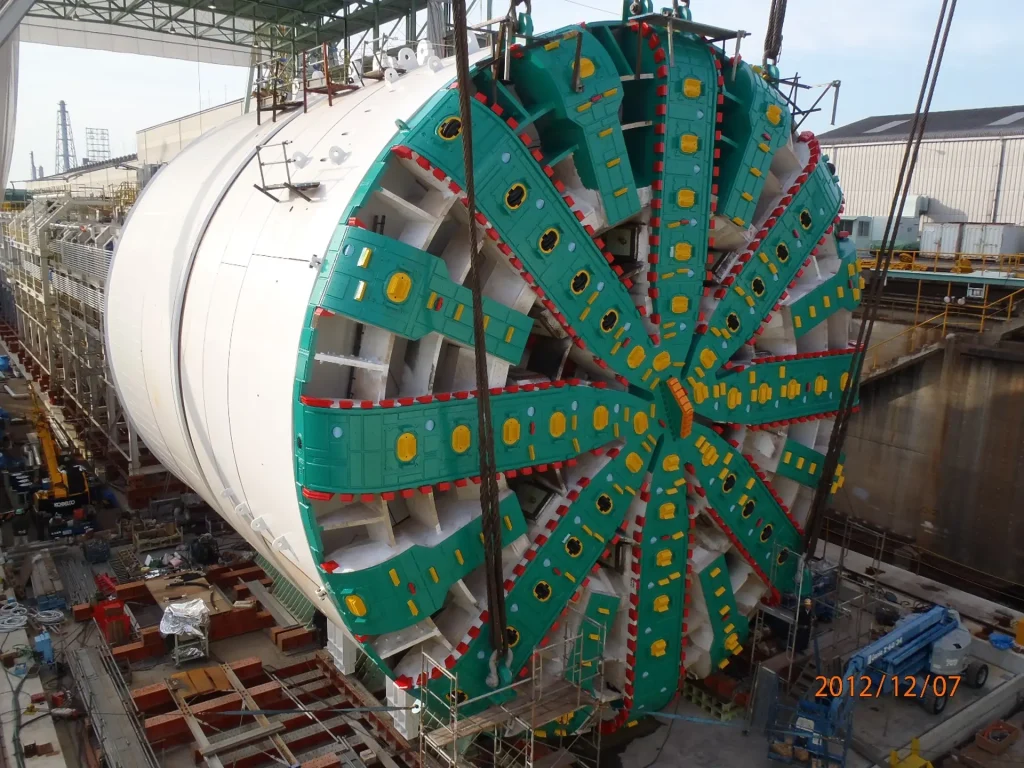
We want to build a customized machine which would allow us to cut horizontal tunnels and place our Family Production Unit (FPU) within that tunnel, in a single-pass.
We want to setup a heavy industry operations to build our own custom Tunnel Boring Machines (TBM) on location. Also this will include the manufacture of industrial diamonds incorporated within the cutting heads of our drilling machines.
See the video link “Making Industrial Diamonds” for more details.
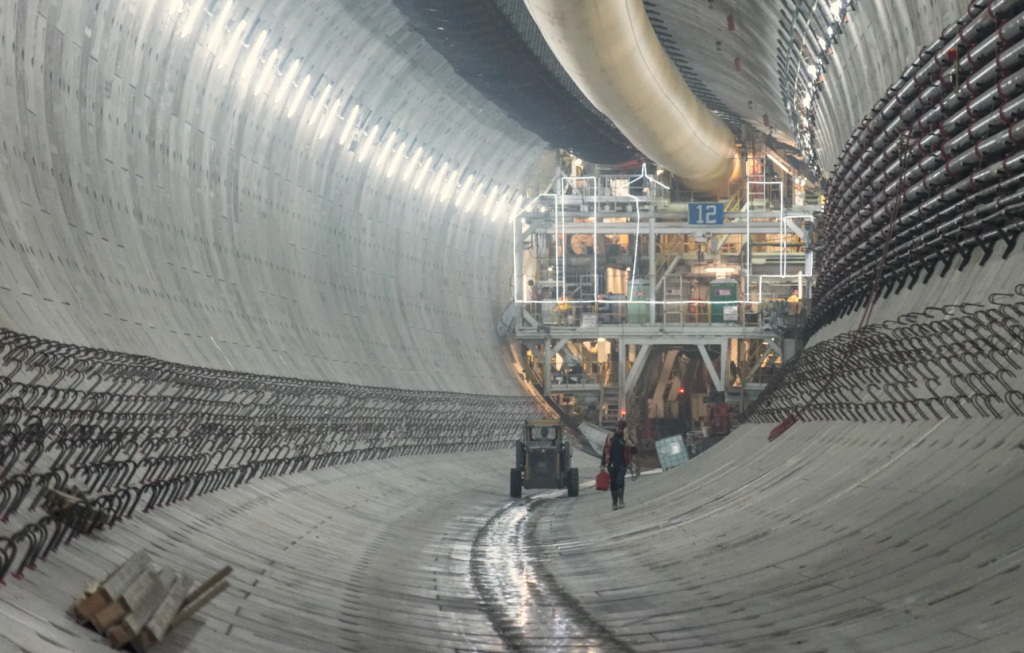
A large diameter tunnel would allow us to place a complete Family Production Unit (FPU) within the tunnel and have the additional space needed for moving people and products within the space provided by the tunnel.

The image above is not to scale but only serves as a simple illustration representing how a double-wide FPU can be installed in the lower-half of the tunnel while a picturesque street view can be created within the top half of the tunnel structure. This (upper-half street view) can recreate any type of environment (including even a sunny “Mediterranean-type” “avenue)! These beautiful avenues will provide a beautiful place for our people to stroll among quaint shops with the entire street “bathed” in warm “recreated” sunshine. Below the street level will be the plant growth tunnels and other related infrastructure that produces food and energy and oxygen needed by our human occupants.
Again, see the video link “Recreated Sunlight” for more details.
Family Production Unit (FPU)
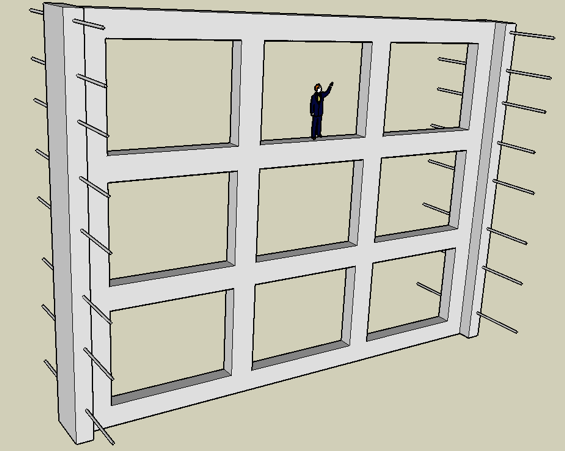
The image above represents a concrete panel that has portals roughly 4 meters square with nine portals per panel. Within these portals we will suspend plant growth tunnels, which provide a protected environment for plant growth.
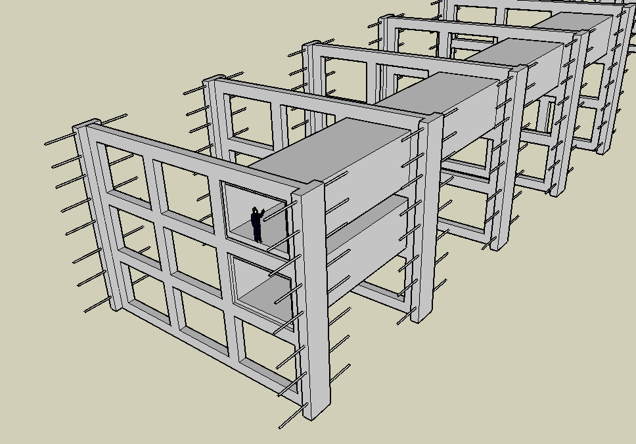
Within these plant-growth tunnels, will have hanging plant-racks that can be moved on a suspended rail to the central work area for servicing (much like a automated “hanging-rack” that moves clothing within a dry-cleaner business). These hanging plant racks will be monitored with cameras and plant growth sensors. These will be rotated to centralized work area for serving and harvest and new replanting procedures as needed.
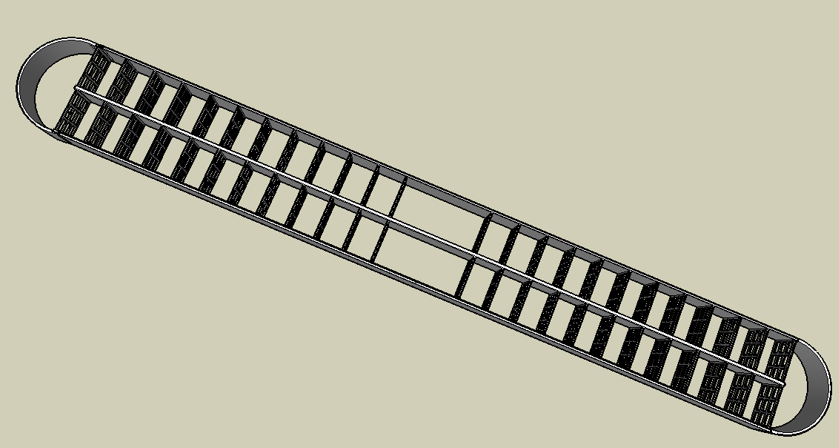
The image above shows the layout of a (FPU) with two rows of panels used for plant growth tunnels. On the ends is a round-cap made of a semicircle that will be used to circulate airflow through the system. The center space (visible in the middle of the FPU) will have three levels with one on the bottom for livestock production, the middle level for food processing and the top level used as a large living residence area for the family owners of this FPU. The plants create oxygen for humans and livestock while the CO2 released by people and animals will be circulated through the plant growth tunnels to provided needed CO2 for plant growth.
We have setup a webpage for our members describing the Family Production Unit (FPU). See the link “Automated Living System” for more details.
Aquaponics Plant Growth System

With modern technology we can now grow plants underground within a protected environment that is safe from all of the hazards that affect surface-grown crops. It is even possible to grow fresh food within harsh environments such as Siberia. In fact this aquaponics technology allows us to grow food in any environment on earth because this system is not dependent upon surface soil conditions.
The water can be circulated through the plant-growth trays and every time the water flows to a lower level then it can also generate electric energy. This is how we can create a self-sufficient system that provides both energy and food and oxygen for our human occupants and livestock within our underground living system.
Underground Industries
When preparing for future events, it is important to reference biblical prophecy which has predicted coming events thousands of years before they transpired. See the link “Prophetic Events” for more details. The coming end-times events will include “One-World Dictatorial Government” and “Instigation of Wars” and “Food Scarcity” and “Decimation of Human Population” and “Mass Culling of Godly People” and “Solar Flares” and “Huge Hail Stones” and numerous other “disastrous events” that will make life difficult for all those who live upon the surface of the whole earth.
Underground Living System and Subsurface Industry
It is our goal to build a completely “self-sufficient” living system underground that can provide energy and food and products needed to sustain human life even during the most difficult times. We will change fiat currency (while it still has value) into “producing assets” that can provide the essentials needed to preserve human life for extended time periods. This system is entirely underground so it is safe from just about every type of natural or manmade disaster that will frequent the earth’s surface in coming times.
Underground Industry
We want to build our industrial system underground so that we can create a safe environment despite the many coming disasters that can affect surface operations. Our food production system can produce food 24-hours a day and 365-days a year so we can have huge food surplus production and this food will be worth more than gold in the coming times of food scarcity.
So, from our underground production facilities we can engage in all types of industry and repair and building of things that will all be in huge demand during a time of worldwide crisis. Our food production will be valued so high that a loaf of bread could be worth a bar of gold, especially when food cannot be found at any price anywhere on the surface of the earth. See the link “Korean Manufacturing” for more details.
Funding
In South Korea, the government has an agency called LH which stands for the Land and Housing department. They are building really modern and advanced apartment homes that are affordable for their citizens. The tenants have to come up with a large deposit and then they qualify for paying a lower monthly rent for ten years. After this ten-year period, then they are eligible to buy their apartment home at a reasonable price. This program is very effective and works well and is good for everyone involved. The large deposit made by the tenants provides capital for the expansion of new projects and the monthly rent paid by tenants also provides continual funding to cover reoccurring administrative costs for LH. One way to think of this is that the tenants pay a large deposit like an investment for LH to use for construction. The lower rent which the the tenants receive is like a “dividend payment” on their investment (since it would cost them a lot more to rent an apartment from a private company). The amount of money they save in paying LH reduced rental cost is the reward or “dividend” they receive for investing their large deposit into LH.
Expanding on the LH Funding System
So in our case, we can receive the land free in Siberia so that is a huge cost savings that we do not need to borrow capital for. The FPU (Family Production Unit) we are going to build is completely self-sufficient and creates energy and food and products for life for every family who owns one. So the cost of the FPU is much higher than buying an apartment with LH. But our FPU includes a large spacious family living space included with the production system. Therefore, even though our FPU is expensive, the same system is also an “income producer” which can pay for itself by the excess food and products that it produces (which can be sold for cash). The family who owns this unit never has to pay electric bills or gas bills and they have no grocery bills because the FPU system produces everything that they need on a perpetual basis. So more of the money generated by the FPU can be allocated toward paying off the construction loan. Therefore, we can afford to assume a higher construction loan from LH because we can pay it off quickly using the income generated by our completed FPU system.
Larger Scale LH Funding System
So we want to have the same system of funding as is currently used by LH for their apartment homes in South Korea, but we want to do this on a larger scale with a much higher construction cost per unit of each of the FPU systems. But the higher construction cost is offset because of the income produced by the completed FPU system. The LH apartments in South Korea could be considered as a “static investment” because they do not produce any income but only give the people a place to live. Our FPU system however provides a much larger home to live in plus a production system that provides energy, food, and products for the life of the owners and creates much excess food and products for sale to create income. Therefore, we can qualify to borrow more investment capital for building each of the FPU systems because at the same time we can generate the wealth to quickly pay off the construction investment loans.
FPU Living System Expansion
This system has the potential to work very well (by paying for itself so that it can also generate more income for expansion). Once the initial loans are paid off, then the income production of the FPU system can be invested continually into our own investment fund. This allows us to build more machinery and allows us to reproduce this system in many locations. This has a “snowball-effect” because the more FPU systems that are completed and the more FPU systems that are paid off, then the more income we have available to direct toward expanding into many remote regions in various locations. Eventually we can have FPU living systems available for a wide range of nationalities and people-groups (those who qualify to be a part of our system) and those “qualified applicants” can also own their own “income-generating” FPU for themselves and their own families. Our first project is a “test case” and once it is perfected (and paid for) then we will have the massive “income-stream” needed for expansion into other locations.
Innovation Development
Recreated Sunlight Underground
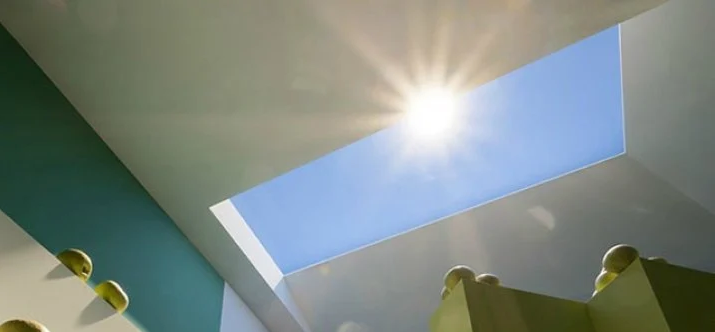
Above is an image of an artificial skylight that actually recreates “real” sunlight underground using the same principles utilized by sunlight passing through the atmosphere around the earth. This technology makes it possible to enjoy sunlight even within a subsurface living system.
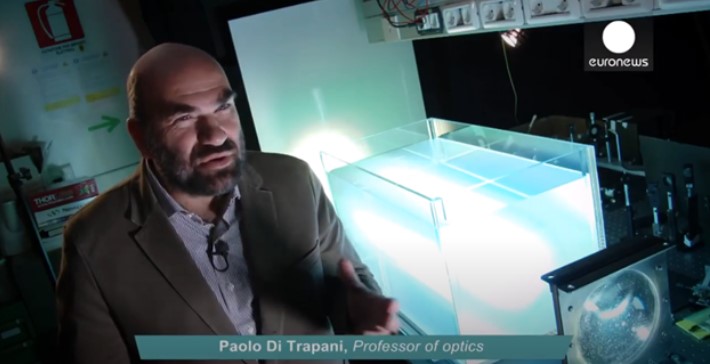
Paolo Di Trapani, Italian professor of optics explains how they can reproduce sunlight by replicating the same system of having rays of the sun pass through the earth’s atmosphere.
See the video link “Recreated Sunlight for more details.
Algae Panels for Food and Oxygen Production
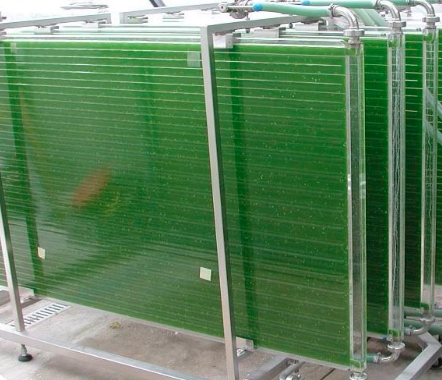
The algae panels pictured above (called a compact plate photobioreactor) are growing spirulina algae which contains complete human nutrition and could enable people to live even if that was the only source of food available to them. This nutritious algae also converts carbon dioxide exhaled by humans or livestock into oxygen making it a perfect “oxygen-producer” for subsurface living systems. Our FPU living system will have all walled surfaces mounted with algae panels similar to these as a source of both food and oxygen.
Aquaponics Energy
Every time that water drops from one level to the next in our aquaponics system then it is used to turn hydroelectric generators. These generators provide the electric energy that we need to run LED plant growth lights within the tunnels. This system enables us to grow plants underground all year round in a controlled environment.
Pelton-Type Hydroelectric Generators
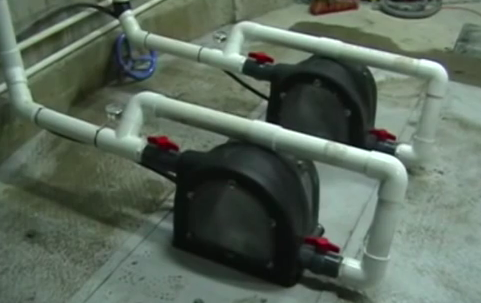
The image above shows two Pelton-type hydroelectric generators that are hooked up in a series using pressured PVC water pipes.
Pelton Rotor Powered by Water Pressure
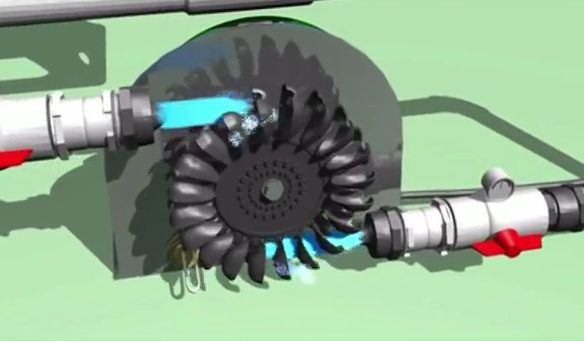
The image above shows how a Pelton rotor is rotated by the use of pressurized water. This rotation is used to spin a Smart Drive motor that produces electric energy.
Pelton Rotor and Smart Drive Motors
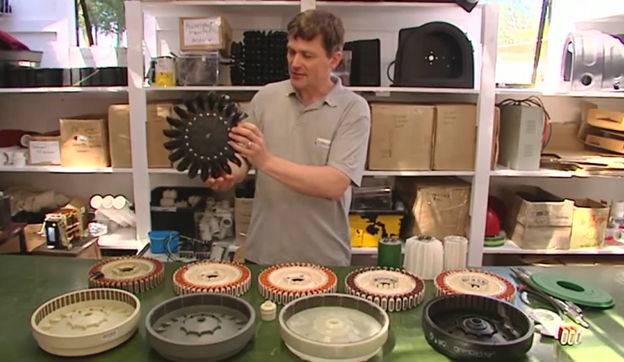
This man in the image above is holding a Pelton rotor which is used to turn smart drive motors (pictured on the table before him). There are magnets within the hubs of these smart drive motors and spinning the magnetic hubs over coils produces electric current.
Smart Drive Motor Rotation by Pelton Rotor
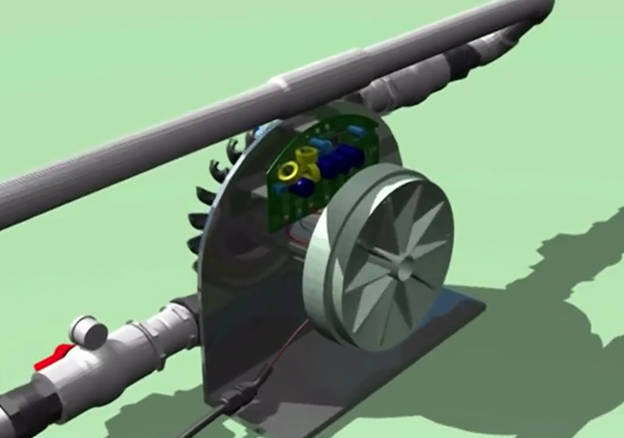
The image above shows a Smart Drive motor that is being rotated by a Pelton rotor under water pressure on the opposite side. This enables the production of electric energy whenever there is a water source that has flowing water from a higher level down to a lower level. This also works when water goes from one level to the next within our “plant-growth” tunnels of our FPU production systems. Thus we can produce energy to operate water pumps and plant-growth lights and this power generation system can meet all of our energy needs.
See the links:
PowerSpout-How it Works-(video)
PowerSpout- Advertisement-(video)
PowerSpout-Tanna Install-(video)
Also see the PowerSpout company site at https://www.powerspout.com/
Airlift Pump called a “Belgium Pipe”
Once the water has flowed from upper levels to lower levels generating power and irrigating plants then it must be lifted again to the highest level to start the cycle over again. We will incorporate an airlift pump for this purpose.
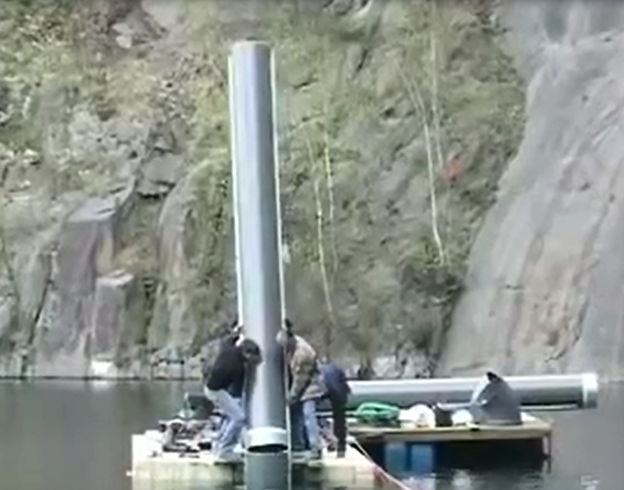
In the image above these men put together some sections of large PVC pipes and attached some air lines to the sides of these pipes. Then they suspended the pipes from a floating platform into a deep lake.
Geyser Produced by an Airlift Pump
The huge geyser of water seen this in this video (linked above) was produced by using only compressed air. The pipe appears to be about 508 mm (20 inches) in diameter but was powered with only a 19 mm (¾ inch) air hose. This is a great multiplication of energy and has the potential to overcome the law of thermal dynamics! By introducing air into the bottom of the pipe they caused a low pressure inside and the higher pressured water outside the pipe entered and caused an upward water flow. The air is lighter than water so the effect of rising bubbles of air up the large pipe produced a lifting effect. This great volume of water was lifted without any moving parts other than the air compressor used to pressurize the system.
See the video link “Belgium Pipe” for more details.
This is an example of common man technology where principles of physics are used to accomplish work. Any water lifted has the potential to do work. Once water has been lifted to a higher level then falling water through the force of gravity can be used to generate electric energy and irrigate plants and provide plant nutrients in an aquaponics system.
Inline Pipe Turbine
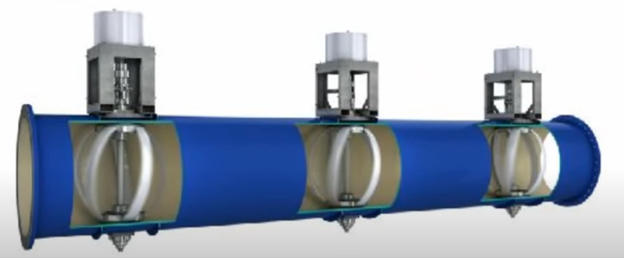
Above is an inline water pipe turbine that can generate electric energy even from the flow of water within mainline water pipes. This is another example of how we can utilize flowing water to generate energy for our living system.
See the video link “Inline Pipe Turbine” for more details.
HD Windows Underground
The video link below shows a HD-video screen that was inserted into a window-frame. Then actual video footage of the outside building “view” was used with some added some “CG-Special Effects” to create a simulated meteor-strike. This video window scene was so “life-like” and “realistic’ that it terrorized those people who had entered the room under the pretext of having a job interview. This is an example of how we can make windows and other aspects of our subsurface living system so “life-like” and “realistic” that it will fool the human senses.
See the video link “HD Windows” for more details.
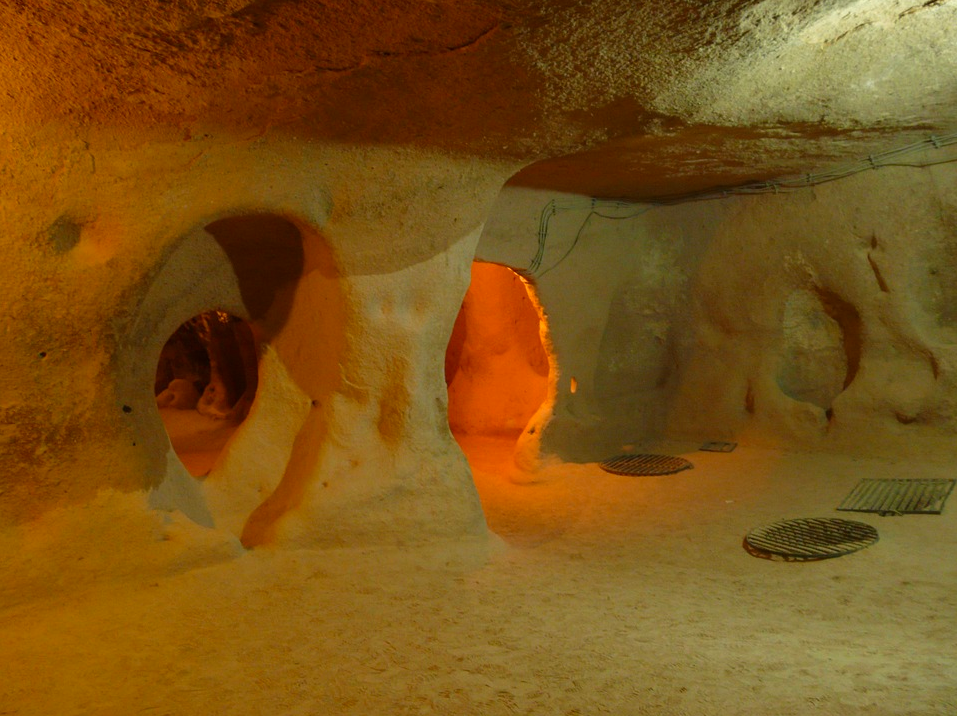
Above is an image of part of an underground city that was created thousands of years ago which was discovered in what is now present-day Turkey. There are been more than 200-underground cities discovered in the area between Kayseri and Nevshir and 40 of these contain three levels or more of subsurface structure complexes.
These underground cities can hold thousands of people and have places for grain storage and storage for olive oil and other food products. There are livestock stables and water-well shafts and ventilation shafts which were all cut out of volcanic rock. All of these subsurface complexes were cut using only hand-tools and manual labor. These structures were so well-hidden that they were not discovered until 1963 when one of the walls was accidently breached revealing miles of tunnels which connected vast areas of chambers and underground living spaces.
This is an example of what can be done to create an underground living system. The ancient system in present-day Turkey was created thousands of years ago using hand-tools and manual labor. But we now have the advantage of using modern machinery and advanced technology. Today we can create a system that has real-sunlight and interactive windows and which produces energy and food and oxygen and products needed to sustain human life underground for indefinite periods of time.
See the video link “Derinkuyu Underground City” for more details.
Also see the link “Pollution Mitigation” for methods used for purifying soil and water in our selected location.
Related Video Links:
Automated System-(video)
Aquaponics 101-(video)
Belgium Pipe-(video)
HD Windows-(video)
Horse Treadmill-(video)
Inline Pipe Turbine-(video)
Khatanga Russia by Cargo Plane-(video)
Khatanga Russia-Clean Up-(video)
Panama Canal Threatened-(video)
PowerSpout-How it Works-(video)
PowerSpout- Advertisement-(video)
PowerSpout-Tanna Install-(video)
Recreated Sunlight-(video)
Tunnels are Safe in Earthquakes-(video)